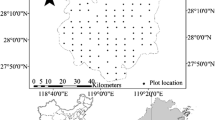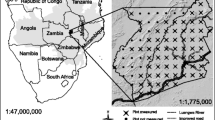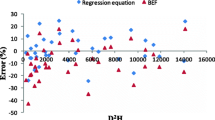Abstract
The commitment to report greenhouse gas emissions requires an estimation of biomass stocks and their changes in forests. When this was first done, representative biomass functions for most common tree species were very often not available. In Germany, an estimation method based on solid volume was developed (expansion procedure). It is easy to apply because the required information is available for nearly all relevant tree species. However, the distributions of neither parameters nor prediction intervals are available. In this study, two different methods to estimate above-ground biomass for Norway spruce (Picea abies), European beech (Fagus sylvatica), and Scots pine (Pinus sylvestris) are compared. First, an approach based on information from the literature was used to predict above-ground biomass. It is basically the same method used in greenhouse gas reporting in Germany and was applied with prior and posterior parameters. Second, equations for direct estimation of biomass with standard regression techniques were developed. A sample of above-ground biomass of trees was measured in campaigns conducted previously to the third National Forest Inventory in Germany (2012). The data permitted the application of Bayesian calibration (BC) to estimate posterior distribution of the parameters for the expansion procedure. Moreover, BC enables the calculation of prediction intervals which are necessary for error estimations required for reporting. The two methods are compared with regard to predictive accuracy via cross-validation, under varying sample sizes. Our findings show that BC of the expansion procedure performs better, especially when sample size is small. We therefore encourage the use of existing knowledge together with small samples of observed biomass (e.g., for rare tree species) to gain predictive accuracy in biomass estimation.






Similar content being viewed by others
Notes
10 because of a unit change from cm to mm and 1/2 because of the change from diameter to radius
References
BMELV (2009) Bundeswaldinventur—Alle Ergebnisse und Berichte. http://www.bundeswaldinventur.de/ 01.05.2013
Gelman A, Carlin JB, Stern HS, Rubin DB (2004) Bayesian data analysis. Chapman and Hall, Boca Raton
Gilks W, Richardson S, Spiegelhalter D (eds) (1995) Markov chain Monte Carlo in practice. Springer, Berlin
Grundner S (1952) Massentafeln zur Bestimmung des Holzgehaltes stehender Waldbäume und Waldbestände, 10th edn. Verlag Paul Parey, Berlin
Hakkila P (1972) Utilisation of residual forest biomass. Springer, Berlin
Kollmann F (1982) Technologie des Holzes und der Holzwerkstoffe, vol 1. Springer, Berlin
Kublin E (2003) Einheitliche Beschreibung der Schaftform—Methoden und Programme—BDATPro. Forstwissenschaftl Centralbl 122(3):183–200
Metropolis N, Rosenbluth A, Rosenbluth M, Teller A, Teller E (1953) Equations of state calculations by fast computing machines. J Chem Phys 21:1087–1092
Muukkonen P (2007) Generalized allometric volume and biomass equations for some tree species in europe. Eur J For Res 126:157–166
Pinheiro JC, Bates DM (2000) Mixed-effects models in S and S-Plus. Springer, Berlin
Pretzsch H (2001) Modellierung des Waldwachstums. Parey, Berlin
R Development Core Team (2009) R: A language and environment for statistical computing. R Foundation for Statistical Computing, Vienna. http://www.R-project.org, ISBN 3-900051-07-0
Saborowski J, Gaffrey D (1999) RBS, Ein mehrstufiges Inventurverfahren zur Schätzung von Baummerkmalen ii. Modifiziertes RBS-verfahren. AFJZ 170(12):223–227
Sprugel D (1983) Correcting for bias in log-transformed allometric equations. Ecology 64:209–210
Umweltbundesamt (2009) Submission under the United Nations Framework Convention on Climate Change and the Kyoto Protocol 2011. German greenhouse gas inventory 1990 - 2009. Tech. rep., Federal Environmental Agency. http://www.umweltbundesamt.de/publikationen/submission-under-united-nations-framework-0
Venables W, Ripley B (2002) Modern applied statistics with S. Statistics and Computing, Springer, Berlin
Wirth C, Schumacher J, Schulze ED (2004) Generic biomass functions for Norway spruce in central europe—a meta-analysis approach towards prediction and uncertainty estimation. Tree Physiol 24:121–139
Wutzler T, Wirth C, Schumacher J (2008) Generic biomass functions for common beech (European beech) in central europe: predictions and components of uncertainty. Can J For Res 38(6):1661–1675
Zapata-Cuartas M, Sierra Ca, Alleman L (2012) Probability distribution of allometric coefficients and Bayesian estimation of aboveground tree biomass. For Ecol Manage 277:173–179 doi:10.1016/j.foreco.2012.04.030
Zianis D, Muukkonen P, Mäkipää R, Mencuccini M (2005) Biomass and stem volume equations for tree species in europe. Silva Fennica 4:63
Acknowledgments
The authors thank Anna Drewek, for reading and discussing the article in the context of WBL-statistics course at ETHZ and Brigitte Rohner, working at WSL in Birmensdorf, for valuable comments on the text, structure and content. We also want to thank the two anonymous referees for their helpful and constructive comments. Further we want to thank Curtis Gautschi for the language corrections.
Author information
Authors and Affiliations
Corresponding author
Additional information
Communicated by Aaron R. Weiskittel.
Appendix
Appendix
For practical usage in standard inventories, simplified models are presented in Table 3. An additive error term with a variance function as presented in “Estimating parameters by regression” section was used.
Rights and permissions
About this article
Cite this article
Zell, J., Bösch, B. & Kändler, G. Estimating above-ground biomass of trees: comparing Bayesian calibration with regression technique. Eur J Forest Res 133, 649–660 (2014). https://doi.org/10.1007/s10342-014-0793-7
Received:
Accepted:
Published:
Issue Date:
DOI: https://doi.org/10.1007/s10342-014-0793-7




